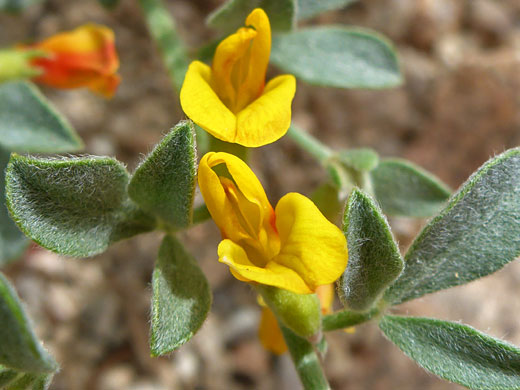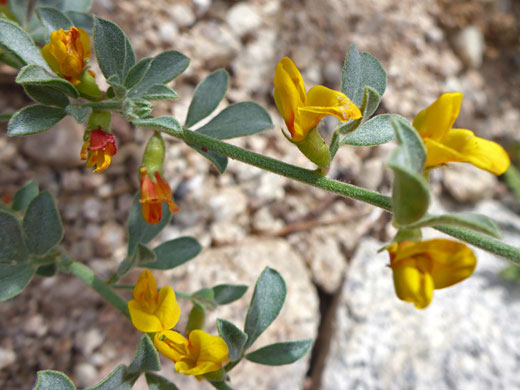
Acmispon procumbens var jepsonii (silky deerweed), Horseshoe Meadows Road, Sierra Nevada, California
Common name:
Silky deerweed
Family:
Scientific name:
Acmispon procumbens
Synonym:
Lotus procumbens
Main flower color:
Range:
Central and southern California
Height:
Up to 3 feet
Habitat:
Roadsides, chaparral, open hillsides; up to 7,500 feet
Leaves:
Approximately palmately divided into three oblanceolate leaflets, up to 0.5 inches long
Season:
April to July
Acmispon procumbens occurs only in California, in the southern Sierra Nevada and other mountains further south. The common name, silky deerweed, refers to the long, soft, strigose hairs that cover the stems, leaves and calyces, giving them a greyish appearance. Stems branch freely, reaching heights of up to 3 feet. Leaves are divided into three leaflets, each attached by very short stalks, generally not quite coinciding at the same point. Leaves have gland-like stipules at the base.
Flowers are produced singly or in groups of two or three, and are essentially stalkless. The yellow corolla often have patches of red or orange, becoming more prominent as they wither. The wing petals are longer than the keel, and approximately equal to the banner. Fruits are hairy, pendent pods, up to 0.6 inches long.
Two varieties are var jepsonii of the Sierra Nevada, for which the calyx tube is equal in length to the calyx lobes, and var procumbens of other areas, for which the calyx tube is significantly longer than the calyx lobes.
Flowers are produced singly or in groups of two or three, and are essentially stalkless. The yellow corolla often have patches of red or orange, becoming more prominent as they wither. The wing petals are longer than the keel, and approximately equal to the banner. Fruits are hairy, pendent pods, up to 0.6 inches long.
Two varieties are var jepsonii of the Sierra Nevada, for which the calyx tube is equal in length to the calyx lobes, and var procumbens of other areas, for which the calyx tube is significantly longer than the calyx lobes.
All Contents © Copyright The American Southwest | Comments and Questions | Contribute | Site Map





